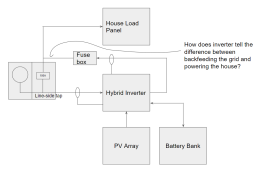Hi y'all:
I'm doing an install on a house that already had solar -- in this case it was an old sunny boy 6000 inverter connected to some (recalled) BP panels, for a total 5.7kW array. Well, I'm getting some money back for the recalled panels, and I thought I'd figure out what my next steps were.
I've already purchased a pallet of Canadian Solar 315W panels, but now I'm trying to figure out what the best ROI system set up would look like.
With NEM 3.0 right around the corner, I'd like to lock in the new size (9.45kW as soon as possible).
Some wrinkles: I'm on a 125A PG&E service / 100A house breaker. The way the solar was set up was using a line tap (bypassing the 100A breaker).
1. In my understanding, that means I'm allowed: 125A * 120% - 100A = 50A of solar, correct (12kW)? I know PG&E don't like doing line taps like this. Any ideas if they'll be ok with hooking more solar up to the same line tap? The wrinkle is I don't think the wiring they used for the tap is 50A rated.
(Alternately, I may end up going with one of their GMA collar thingies...)
2. The existing inverter is definitely not Rule 21 rated. Thoughts about just replacing the panels and keeping quiet for that section? I'd permit the additional (9.45kW - existing 5.7kW = +3.75kW) as a "new" install with RSD / new inverter... Since all the panels are off the roof, I'd just "replace" the existing panels after the fact...
3. I've been looking at potentially off-grid stuff. Are there any viable (cheaper) alternatives to the Sol-Ark stuff that's Rule 21 certified? Otherwise, I think I'm just going to go grid-tie and get a cheapie SMA 7.7KW.
4. Finally, I've been considering upgrading my service to 200A. Unfortunately, PG&E want like 8 months to draw up the plans, and who-knows how much money to actually do the install. Anyone have experience with that?
Thoughts?
I'm doing an install on a house that already had solar -- in this case it was an old sunny boy 6000 inverter connected to some (recalled) BP panels, for a total 5.7kW array. Well, I'm getting some money back for the recalled panels, and I thought I'd figure out what my next steps were.
I've already purchased a pallet of Canadian Solar 315W panels, but now I'm trying to figure out what the best ROI system set up would look like.
With NEM 3.0 right around the corner, I'd like to lock in the new size (9.45kW as soon as possible).
Some wrinkles: I'm on a 125A PG&E service / 100A house breaker. The way the solar was set up was using a line tap (bypassing the 100A breaker).
1. In my understanding, that means I'm allowed: 125A * 120% - 100A = 50A of solar, correct (12kW)? I know PG&E don't like doing line taps like this. Any ideas if they'll be ok with hooking more solar up to the same line tap? The wrinkle is I don't think the wiring they used for the tap is 50A rated.
(Alternately, I may end up going with one of their GMA collar thingies...)
2. The existing inverter is definitely not Rule 21 rated. Thoughts about just replacing the panels and keeping quiet for that section? I'd permit the additional (9.45kW - existing 5.7kW = +3.75kW) as a "new" install with RSD / new inverter... Since all the panels are off the roof, I'd just "replace" the existing panels after the fact...
3. I've been looking at potentially off-grid stuff. Are there any viable (cheaper) alternatives to the Sol-Ark stuff that's Rule 21 certified? Otherwise, I think I'm just going to go grid-tie and get a cheapie SMA 7.7KW.
4. Finally, I've been considering upgrading my service to 200A. Unfortunately, PG&E want like 8 months to draw up the plans, and who-knows how much money to actually do the install. Anyone have experience with that?
Thoughts?




